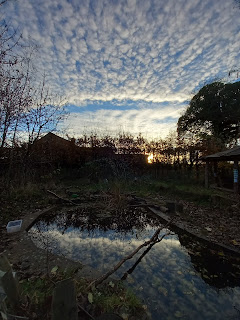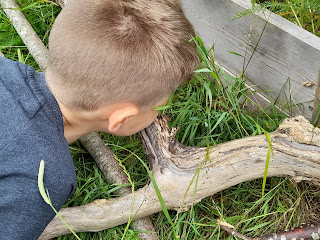FUN!
 The purpose of Forest School is to engage in Nature. It doesn't necessarily mean having a task or a plan, we follow the children's interests and build on those. Often if you explain that the outdoor area would benefit from a Bug House, or how useful a Bird Box or two could be, the children are eager to help. However, in order to really enjoy nature you need to immerse yourself in it, get to grips with bark and boughs, enjoy the breeze on your face, learn to respect the outdoors and find what it is about you as an individual loves...
The purpose of Forest School is to engage in Nature. It doesn't necessarily mean having a task or a plan, we follow the children's interests and build on those. Often if you explain that the outdoor area would benefit from a Bug House, or how useful a Bird Box or two could be, the children are eager to help. However, in order to really enjoy nature you need to immerse yourself in it, get to grips with bark and boughs, enjoy the breeze on your face, learn to respect the outdoors and find what it is about you as an individual loves...For Year 3 this most definitely climbing trees!
The higher the better
It does cause a minor heart flutter at times, but like anything in life there are parameters to be met to keep you as safe as possible.

Our basic tree climbing rules are:
- Tell an adult if you are going to climb so they can watch
- Look up and plan a route
- look down and know at each stage how you intend to get back down
- before you climb, wrap your hand around your wrist, feel how thick it is - never hold onto or stand on a branch thinner than this as it is unlikely to take your weight
- stay close to the trunk
- you have 7 'patches' on your body: 2 hands, 2 feet, 2 knees and your bottom! At LEAST three of these MUST be in contact with the tree at all times
We do talk about dead wood and living wood but it isn't always easy for young children to recognise the difference, so adults select suitable trees to climb. And we choose BIG trees. Not Mama Beech, as huge and strong as she is she is not suitable to climb, but those that are can easily support 2 or 3 children at a time, and as long as there are observed, and careful they can climb together.
When they do, we find they instantly offer advice, look out for each other, talk their peers through routes up and down, offer encouragement and praise, and share each other's achievements in dexterity, bravery and pride.
Children who watch in week 1 usually try the first branch, even if it's just in a monkey-bar style, by week 4.
Children readily admit they are scared, that their heart is banging in their chest, but they push themselves a little further anyhow, they are amazed to learn that's what being truly brave is: being scared and doing it anyway.
And a tree is the very best gym equipment you will find!




Comments
Post a Comment